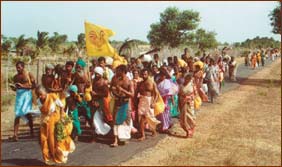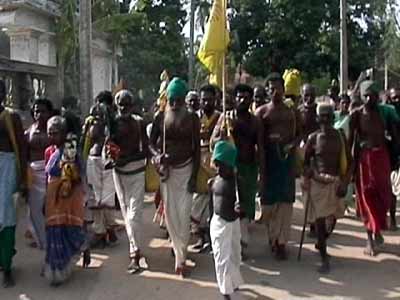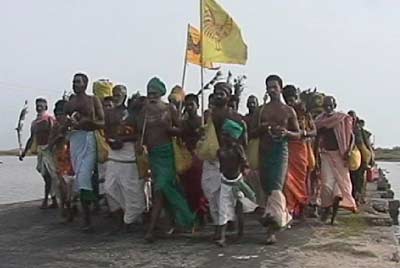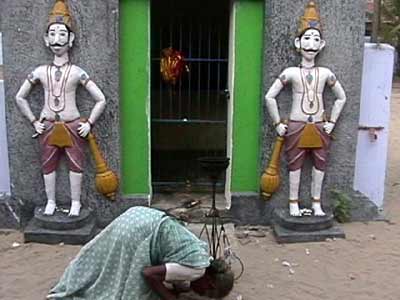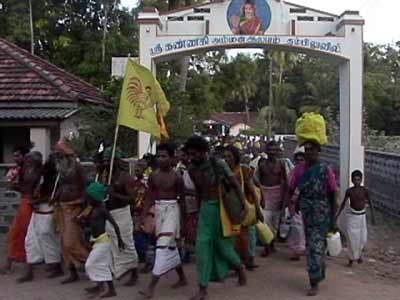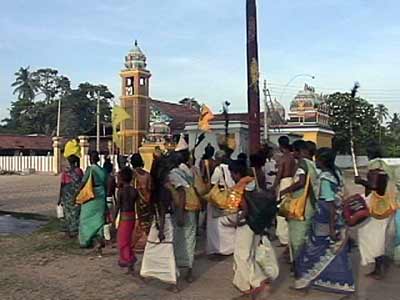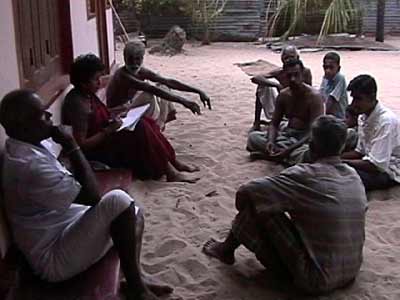
|
|||||||||
|
| |||||||||
 Pada Yatra: On the final stretch
|
|
In May 2004 Kataragama devotees set out from Jaffna on the traditional two-month trek to God Skanda's sylvan shrine in the far South. Now their ranks are growing daily as hundreds of villagers join in the largest Kataragama Pada Yatra seen in over twenty years. |
Sinhalese and foreign devotees together with several hundreds of Tamil devotees of all ages from the North and East are now passing through Ampara District as the traditional two-month pada yatra or foot pilgrimage from Jaffna shortly enters Kataragama Kaele, ‘the God's own Forest'.
Even veteran observers have been surprised by the scale of this year's turnout, with several hundreds of villagers of all ages joining the Pada Yatra even before it had reached Batticaloa district. The ‘Adiyar Kuttam' party of pilgrims originating from Jaffna alone already counts some 400 members, with more and more villagers joining daily.
Flag-hoisting
Some villages, like Mamangam near Batticaloa and others, have formed their own pada yatra societies of a hundred members or more, most of whom set out from popular starting points like Pottuvil and Okanda in the second week of July. With the Okanda Murugan Devale and Kataragama Maha Devale flag-hoisting ceremonies both occurring on 17 July, several thousands of foot pilgrims are expected to be on the move at that time.
In recent years, the ancient tradition has been making a comeback after facing near-extinction following the 1983 ethnic riots. Only with the formation of the Kataragama Devotees Trust or KDT in 1988 and subsequent efforts to revive the tradition did old and new pilgrims begin to turn out again in numbers in the mid-1990's. In recent years up to ten thousand pilgrims annually walk the final 100-kilometre stretch through Yala National Park.
Pageant
On 21 May, pilgrims from the island's North, East and West including foreign devotees assembled near Jaffna at Selva Sannidhi Murugan Kovil, recited their vows and proceeded south with spirited cries of ‘Haro Hara!'
Villagers in Jaffna, Kilinochchi and Mullaittivu districts, who for decades had not witnessed the sight of Pada Yatra, were astonished to see the colourful band, and gladly offered traditional offerings of refreshments and annadanam. Not only villagers, but also the LTTE and Sri Lanka Army have been offering the pilgrims annadanam and help whenever needed.
It was only at the grand Kannaki Amman (Pattini) festival at Vattappalai on 31 May that the party from Jaffna was met and joined by dozens of veteran pilgrims from all over the island. Overnight, the small party grew into a colorful band of pilgrims dressed in the characteristic red, yellow, or green garments typical of God Skanda's pilgrim devotees.
Some pilgrims may be seen carrying the God's bright red and yellow cock banner; others wave peacock feathers; while senior swamis bear aloft the vel or lance, symbol of the God's invincible brilliance. Even small children dressed in vetti may be heard shouting ‘Haro Hara!' (‘Hallelujah') and joining in the constant recital of bhajanas in praise of God Kataragama.
Foot pilgrims wear traditional dress only: vettis and shawl for men, saris for women. Trousers and shirt are considered inappropriate dress for pilgrims. Slippers may be worn when absolutely necessary, but not shoes. Pilgrims sleep out of doors at night or in temples, but not in private homes. Elder pilgrims especially enjoy the respect of villagers and pilgrims alike, who consider them as treasuries of age-old oral traditions. Consumption of alcohol is strictly prohibited.
Many villagers make vows to join the Pada Yatra as it passes through their own village, so the parties of pilgrims tend to grow day by day. With just a few weeks remaining before the flag-hoisting ceremonies at Okanda and Kataragama, thousand of pilgrims are expected to join or follow the pilgrims as they pass through Ampara district and enter Yala National Park.
In recent years hundreds–even thousands–of villagers have resumed coming by foot from points like Pottuvil and Okanda that are just a week's walk from Kataragama. However this year, for the first time, hundreds of villagers of all ages have been joining the Pada Yatra already even from Trincomalee district, more than a month's rigorous march from Kataragama.
Hazards
Wildlife Department officials, expecting an even bigger turnout than last year, are monitoring the flow of pilgrims who walk from Pottuvil via Okanda and Kumuna, through the Strict Natural Reserve to the banks of the Menik Ganga and thence to Kataragama. KDT officials also, some on foot and others in support vehicles, annually monitor environmental and health conditions inside the park during the height of the Pada Yatra season.
According to KDT spokesman Manik Sandrasagra, the rush of inexperienced pilgrims through Yala brings with it environmental and health hazards. "This year we are again helping the Wildlife Department to minimize the fire hazard, reduce littering in the park, and maintain public health especially by monitoring sources of drinking water."
"The Wildlife Department has been making admirable efforts to protect the park while also trying to meet the pilgrims' needs, especially for safe drinking water. But with thousands of pilgrims crossing at once, it is no easy task."
Villagers' ideas
The Pada Yatra pilgrims are not only praying for peace, but are also doing something to help establish island-wide peace, justice and prosperity.
Last year the Pada Yatra swamis and swami ammas invited villagers all along their route to articulate local development problems together with proposed solutions. The project, called ‘Let the Villagers be Heard', which interviewed hundreds of villagers in 40 villages in Trincomalee, Batticaloa and Ampara districts, was the brain child of the Living Heritage Trust.
The project was such a success that this year it has been expanded to cover over 60 villages in seven conflict-affected districts from Jaffna to Ampara district. Pada Yatra pilgrims themselves are conducting the project.
Already several thousand villagers have participated by completing questionnaires in Tamil and Sinhala that invite them to articulate local social and economic development issues, including security, education, health, employment, agriculture, and other government services. Survey results from some 5,000 participating villagers in seven districts will be compiled, analyzed, and reported to concerned ministries and development agencies after the Kataragama festival is over.
The project aims to stimulate open discussions, encourages villagers to articulate solutions to local development issues, collects villagers' own appraisals of local problems and ideal solutions, and forwards results to concerned agencies to be factored into ministerial planning of regional development programs.
Most villages in the North and East are populated by Tamil speakers. The survey, however, also specially visits Sinhalese coastal enclaves such as Seruvila, whose residents face their own unique set of local challenges in building a multi-ethnic society that ensures peace, justice, and prosperity for all its citizens.
The Kataragama Pada Yatra has for centuries been one of the great unifying factors in Sri Lankan society. Even today, the tradition continues to play an important role in the long process
Ancient Tradition
Since 1988 the KDT has annually coordinated the yatra by notifying devotees and temples all up and down the East Coast. It also helps to facilitate dana, the ritual sharing of food and hospitality, by informing temple societies of the pilgrims' arrival dates and by providing free dry rations to hundreds of poor pilgrims who undertake the six-day crossing of Kataragama Kaele, ‘the God's own Forest'.
The Pada Yatra pilgrims walk from as far as Jaffna and Mullaittivu districts, taking up to two months to reach the distant shrine. All along the way, villagers wait for their chance to offer dana to the growing bands of swamis and swami ammas, who are mostly in their 50's, 60's and 70's—some even in their 90's.
This year is the 17th consecutive Pada Yatra sponsored by the Kataragama Devotees Trust since 1988 with the support of villagers and officials at the national, district and local levels.
Courtesy: The Sunday Observer (Colombo) of 25 July 2004
Patrick Harrigan has been the Kataragama Devotees Trust's pada yatra field representative since 1988. The 2004 pada yatra is his 18th Kataragama Pada Yatra since 1972.
2004 Pada Yatra 2004 report #1: Jaffna to Trincomalee
Kataragama.org official website of the Kataragama Guru Paramparā
|
|
| Living Heritage Trust ©2023 All Rights Reserved |
